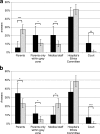Decision-making at the limit of viability: differing perceptions and opinions between neonatal physicians and nurses
- PMID: 29471821
- PMCID: PMC5822553
- DOI: 10.1186/s12887-018-1040-z
Decision-making at the limit of viability: differing perceptions and opinions between neonatal physicians and nurses
Erratum in
-
Correction to: decision-making at the limit of viability: differing perceptions and opinions between neonatal physicians and nurses.BMC Pediatr. 2018 Jul 9;18(1):226. doi: 10.1186/s12887-018-1204-x. BMC Pediatr. 2018. PMID: 29986696 Free PMC article.
Abstract
Background: In the last 20 years, the chances for intact survival for extremely preterm infants have increased in high income countries. Decisions about withholding or withdrawing intensive care remain a major challenge in infants born at the limits of viability. Shared decision-making regarding these fragile infants between health care professionals and parents has become the preferred model today. However, there is an ongoing ethical debate on how decisions regarding life-sustaining treatment should be reached and who should have the final word when health care professionals and parents do not agree. We designed a survey among neonatologists and neonatal nurses to analyze practices, difficulties and parental involvement in end-of-life decisions for extremely preterm infants.
Methods: All 552 physicians and nurses with at least 12 months work experience in level III neonatal intensive care units (NICU) in Switzerland were invited to participate in an online survey with 50 questions. Differences between neonatologists and NICU nurses and between language regions were explored.
Results: Ninety six of 121 (79%) physicians and 302 of 431(70%) nurses completed the online questionnaire. The following difficulties with end-of-life decision-making were reported more frequently by nurses than physicians: insufficient time for decision-making, legal constraints and lack of consistent unit policies. Nurses also mentioned a lack of solidarity in our society and shortage of services for disabled more often than physicians. In the context of limiting intensive care in selected circumstances, nurses considered withholding tube feedings and respiratory support less acceptable than physicians. Nurses were more reluctant to give parents full authority to decide on the course of action for their infant. In contrast to professional category (nurse or physician), language region, professional experience and religion had little influence if any on the answers given.
Conclusions: Physicians and nurses differ in many aspects of how and by whom end-of-life decisions should be made in extremely preterm infants. The divergencies between nurses and physicians may be due to differences in ethics education, varying focus in patient care and direct exposure to the patients. Acknowledging these differences is important to avoid potential conflicts within the neonatal team but also with parents in the process of end-of-life decision-making in preterm infants born at the limits of viability.
Keywords: End-of-life decisions; Extremely preterm infants; Health care professionals; Neonatal intensive care; Previable period; Shared decision-making.
Conflict of interest statement
Ethics approval and consent to participate
The Ethics Committee of the Canton Zurich confirmed on request that no formal approval of this survey is required. (see manuscript methods) Informed consent was electronically obtained from each respondent before filling out the online questionnaire.
Consent for publication
Not applicable
Competing interests
The authors declare that they have no competing interests.
Publisher’s Note
Springer Nature remains neutral with regard to jurisdictional claims in published maps and institutional affiliations.
Figures


References
-
- Marlow N. Keeping up with outcomes for infants born at extremely low gestational ages. JAMA Pediatr. 2015;169(3):3–4. - PubMed
-
- Fanaroff JM, Hascoet JM, Hansen TWR, Levene M, Norman M, Papageorgiou A, Shinwell E, van de Bor M, Stevenson DK. Ipc: the ethics and practice of neonatal resuscitation at the limits of viability: an international perspective. Acta Paediatr. 2014;103(7):701–708. - PubMed
-
- Berger TM, Steurer MA, Bucher HU, Fauchere JC, Adams M, Pfister RE, Baumann-Hoelzle R. Bassler D, on behalf of the Swiss neonatal end-of-life study group, Euronic study group: retrospective cohort study of all deaths among infants born between 22-27 completed weeks of gestation in Switzerland over a three-year period. BMJ Open. 2017;7:e015179. - PMC - PubMed
-
- Hellmann J, Knighton R, Lee SK, Shah PS. Neonatal deaths: prospective exploration of the causes and process of end-of-life decisions. Arch Dis Child Fetal Neonatal Ed. 2016;101(2):F102–F107. - PubMed
-
- Verhagen AA, Dorscheidt JH, Engels B, Hubben JH, Sauer PJ. End-of-life decisions in Dutch neonatal intensive care units. Archives of pediatrics & adolescent medicine. 2009;163(10):895–901. - PubMed
Publication types
MeSH terms
Grants and funding
LinkOut - more resources
Full Text Sources
Other Literature Sources

